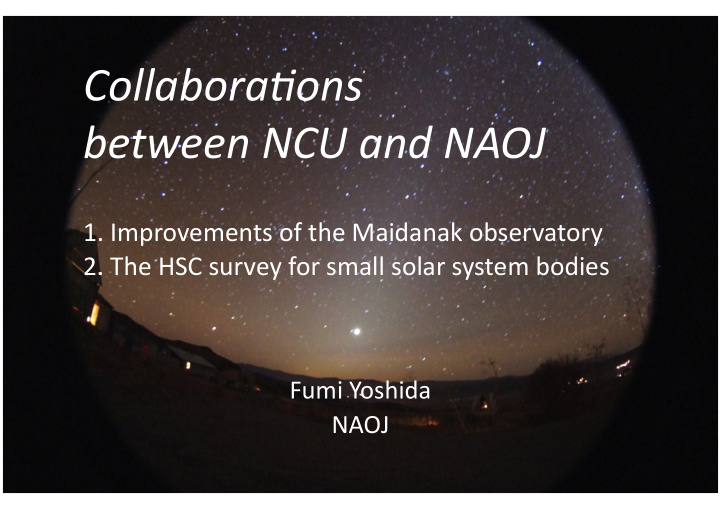



Collabora'ons between NCU and NAOJ 1. Improvements of the Maidanak observatory 2. The HSC survey for small solar system bodies Fumi Yoshida NAOJ
Maidanak Observatory, Uzbekistan
1.5m 1m 60cm
History of a research collaboraHon between NAOJ and Maidanak • 2003.08: Asteroids observaHon with the 1.5 m telescope Personal collabora'on started (F. Yoshida & S. Takahashi) • 2004.12: Agreement of research collaboraHon between NAOJ and UBAI (PI. T. Nakamura) Official collabora'on started • 2005.03: Equipped a CCD camera to the 60 cm telescope • 2006.04 – 2009.03 This research was funded by Grant‐in‐Aid (MEXT) to a great deal (PI. F. Yoshida) • 2009.04 (1ll 2012.03) This research will covered by JSPS fund partly (PI. T. Ito). Regular asteroid observaHon using 50% of the 60 cm telescope Hme has been conHnued unHl now.
This year (2009) (1) 1 st Maidanak users meeHng in Seoul on June 30 (2) Cleaning 60cm mirror Spare mirror (3) Set up data storage system (4) Send the 60cm mirror to Okayama (5) Training/experience Next year (2010) at NAOJ and JAXA (1) Set up the re‐aluminized mirror in Feb. (2) 2 nd Maidanak users meeHng (3) Digitalize the driving gear of 60cm telescope ← If we get the Grant‐in‐Aid fund. (4) IntroducHon of a new generator (?) ← Money from NCU also?
Cleaning of the 60cm mirror in Aug. 2009 Before Aaer Reflectance 67.7% 81.1% Scaeerometer clean water, alcohol, and coeon wipe with coeon soaked with alcohol
ObservaHons (>17.5 mag), some results 2006 peak‐to‐peak Iannini family (5) vs. P ‐1 Karin family (2) Veritas family (15) Young families Old families 2007 Iannini family (2) Karin family (3) Veritas family (15) 2008 Iannini family (1) Veritas family (15) Lightcurves & colors
Related publicaHons
Hyper Suprime‐Cam (HSC) survey in 2012‐2016 • HSC survey is not an all sky survey • Time allocaHon : 300 days / 5 years Hyper Suprime‐Cam (not fixed yet) • FOV : 1.5 deg 2 (cf. FOV of Suprime‐ Major science of the HSC survey Cam: 0.25 deg 2 ) • Understanding the nature of dark energy • Exploring the large‐scale structure • Studying the galaxy formaHon process • Understanding the nature of AGNs • Exploring the transient and variable objects (SNs, GRBs etc.) • Understanding the planetary formaHon history of the Solar System
Small solar system bodies are always moving. Since the detecHon limit depends on the velocity, each populaHon 4 dynamical has different detecHon limit as below. class Resonant Classical Hildas Jupiter Trojans Scaeered Oort Detached cloud NEAs MBAs TNOs Inner Oort cloud 24.4 24.7 26‐28 DetecHon limit (R) with the Suprime‐Cam Pan‐STARRS < 24mag In the case that we use many images and stack them along TNO’s LSST 24.7 mag (deep survey (limited area) 27.5 mag) movement. HSC is the most suitable tool to explore outer solar system
Inner region (on eclipHc plane) Various sciences from NEAs to inner Oort cloud We want to know the history and dynamical evoluHon from planetary formaHon up to now . Science proposals 1. Exploring source of NEAs in the MBAs Outer region (on eclipHc plane) 2. InvesHgaHng TNO dynamical classes 3. Exploring evidence of giant planet migraHon 4. Exploring new Binary TNOs 5. Exploring “Planet X”, eccentric large TNOs, inner‐Oort cloud objects High laHtude 6. InvesHgaHng origin of meteorites region 7. Exploring origin of Jupiter Family Comets 8. InvesHgaHng characterisHc of fast rotators
The HSC Solar System Science Group NCU Princeton University • NAOJ/NINS Wing‐Huen Ip Fumi Yoshida Ed Turner Takashi Ito Shinsuke Abe Amaya Moro‐Marsn Shigeru Takahashi Daisuke Kinoshita Steve Bickerton • ISAS/JAXA Hsin‐Wen Lin Toshifumi Yanagisawa Ying‐Tong Chen Hirohisa Kurosaki Chan‐Kao Chang Makoto Yoshikawa • Kobe University Tsuyoshi Terai • Kinki Univ. Patryk Lykawka • JSGA Why only Japan, Taiwan and Princeton ? Seitaro Urakawa Because their insHtutes contributed a large • TITec amount of budget to the HSC producHon. Arika Higuchi
Thank you very much
Recommend
More recommend